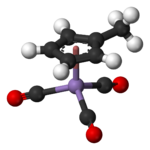Methylcyclopentadienyl manganese tricarbonyl
 |
|
 |
|
| Names | |
|---|---|
|
IUPAC names
tricarbonyl(methyl-η5-
cyclopentadienyl)manganese |
|
| Other names
MMT, CI-2, Combustion Improver-2, Manganese tricarbonylmethylcyclopentadienyl, 2-Methylcyclopentadienyl manganese tricarbonyl
|
|
| Identifiers | |
|
12108-13-3 |
|
| ECHA InfoCard | 100.031.957 |
| RTECS number | OP1450000 |
| Properties | |
| C9H7MnO3 | |
| Molar mass | 218.09 g/mol |
| Appearance | pale yellow to dark orange liquid |
| Odor | faint, pleasant |
| Density | 1.38 g/cm3 |
| Melting point | −1 °C (30 °F; 272 K) |
| Boiling point | 232 to 233 °C (450 to 451 °F; 505 to 506 K) |
| low | |
| Solubility in other solvents | alkane (petrol) |
| Vapor pressure | 7 mmHg (100°C) |
| Structure | |
| Tetrahedral at Mn | |
| Hazards | |
| Main hazards | flammable, toxic to skin and inhalation |
|
EU classification (DSD)
|
 
|
| R-phrases | 23/24/25-40 |
| S-phrases | 23-26-36/37/39-45 |
| Flash point | 110 °C; 230 °F; 383 K |
| US health exposure limits (NIOSH): | |
|
PEL (Permissible)
|
C 5 mg/m3 |
|
REL (Recommended)
|
TWA 0.2 mg/m3 [skin] |
|
IDLH (Immediate danger)
|
N.D. |
| Related compounds | |
|
Related compounds
|
ferrocene Mn2(CO)10 dicyclopentadiene |
|
Except where otherwise noted, data are given for materials in their standard state (at 25 °C [77 °F], 100 kPa).
|
|
|
|
|
| Infobox references | |
Methylcyclopentadienyl manganese tricarbonyl (MMT or MCMT) is an organomanganese compound with the formula (CH3C5H4)Mn(CO)3. Initially marketed as a supplement for use in leaded gasoline, MMT was later used in unleaded gasoline to increase the octane rating. Following the implementation of the Clean Air Act (United States) (CAA) in 1970, MMT continued to be used alongside tetraethyl lead (TEL) in the US as leaded gasoline was phased out (prior to TEL finally being banned from US gasoline in 1995), and was also used in unleaded gasoline until 1977. Ethyl Corporation obtained a waiver from the U.S. EPA (Environmental Protection Agency) in 1995, which allows the use of MMT in US unleaded gasoline (not including reformulated gasoline) at a treat rate equivalent to 8.3 mg Mn/L (manganese per liter).
MMT has been used in Canadian gasoline since 1976 (and in numerous other countries for many years) at a concentration up to 18 mg Mn/L (though the importation and interprovincial trade of gasoline containing MMT was restricted briefly during the period 1997-1998) and was introduced into Australia in 2000. It has been sold under the tradenames HiTEC® 3000, Cestoburn and Ecotane.
Though initially marketed in 1958 as a smoke suppressant for gas turbines, MMT was further developed as an octane improver in 1974. When the United States Environmental Protection Agency (EPA) ordered the phase out of TEL in gasoline in 1973, new fuel additives were sought. TEL has been, and still is, used in certain countries as an additive to increase the octane rating of automotive gasoline.
In 1977, the US Congress amended the CAA to require advance approval by the EPA for the continued use of fuel additives such as MMT, ethanol, ethyl tert-butyl ether (ETBE), etc. The new CAA amendment required a “waiver” to allow use of fuel additives made of any elements other than carbon, hydrogen, oxygen (within certain limits) and nitrogen. To obtain a waiver, the applicant was required to demonstrate that the fuel additive would not lead to a failure of vehicle emission control systems.
Ethyl Corporation (Ethyl) applied to the US EPA for a waiver for MMT in both 1978 and 1981; in both cases the applications were denied because of stated concerns that MMT might damage catalytic converters and increase hydrocarbon emissions. In 1988, Ethyl began a new series of discussions with the EPA to determine a program for developing the necessary data to support a waiver application. In 1990, Ethyl filed its third waiver application prompting an extensive four-year review process. In 1993, the U.S. EPA determined that use of MMT at 8.3 mg Mn/l would not cause, or contribute to, vehicle emission control system failures.
...
Wikipedia
